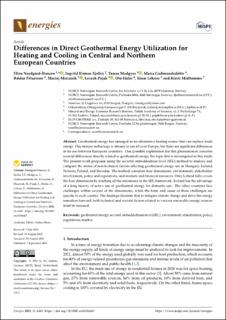| dc.contributor.author | Nordgård-Hansen, Ellen Marie | |
| dc.contributor.author | Fjellså, Ingvild Firman | |
| dc.contributor.author | Medgyes, Tamás | |
| dc.contributor.author | Guðmundsdóttir, María | |
| dc.contributor.author | Pétursson, Baldur | |
| dc.contributor.author | Miecznik, Maciej | |
| dc.contributor.author | Pająk, Leszek | |
| dc.contributor.author | Halás, Oto | |
| dc.contributor.author | Leknes, Einar | |
| dc.contributor.author | Midttømme, Kirsti | |
| dc.date.accessioned | 2023-09-22T06:34:51Z | |
| dc.date.available | 2023-09-22T06:34:51Z | |
| dc.date.created | 2023-09-07T13:48:17Z | |
| dc.date.issued | 2023 | |
| dc.identifier.citation | Energies. 2023, 16 . | en_US |
| dc.identifier.issn | 1996-1073 | |
| dc.identifier.uri | https://hdl.handle.net/11250/3091237 | |
| dc.description.abstract | Geothermal energy has emerged as an alternative heating source that can replace fossil energy. This mature technology is already in use all over Europe, but there are significant differences in its use between European countries. One possible explanation for this phenomenon concerns societal differences directly related to geothermal energy, the topic that is investigated in this study. The present work proposes using the societal embeddedness level (SEL) method to analyze and compare the status of non-technical factors affecting geothermal energy use in Hungary, Iceland, Norway, Poland, and Slovakia. The method considers four dimensions: environment, stakeholder involvement, policy and regulations, and markets and financial resources. Only Iceland fully covers the four dimensions by reaching all the milestones in the SEL framework. Iceland has the advantage of a long history of active use of geothermal energy for domestic use. The other countries face challenges within several of the dimensions, while the form and cause of these challenges are specific to each country. The findings illustrate that to mitigate climate change and drive the energy transition forward, both technical and societal factors related to various renewable energy sources must be assessed. | en_US |
| dc.description.abstract | Differences in Direct Geothermal Energy Utilization for Heating and Cooling in Central and Northern European Countries | en_US |
| dc.language.iso | eng | en_US |
| dc.rights | Navngivelse 4.0 Internasjonal | * |
| dc.rights.uri | http://creativecommons.org/licenses/by/4.0/deed.no | * |
| dc.title | Differences in Direct Geothermal Energy Utilization for Heating and Cooling in Central and Northern European Countries | en_US |
| dc.title.alternative | Differences in Direct Geothermal Energy Utilization for Heating and Cooling in Central and Northern European Countries | en_US |
| dc.type | Peer reviewed | en_US |
| dc.type | Journal article | en_US |
| dc.rights.holder | © 2023 by the authors | en_US |
| dc.description.version | publishedVersion | en_US |
| cristin.ispublished | true | |
| cristin.fulltext | original | |
| cristin.qualitycode | 1 | |
| dc.identifier.doi | 10.3390/en16186465 | |
| dc.identifier.cristin | 2173251 | |
| dc.source.journal | Energies | en_US |
| dc.source.volume | 16 | en_US |
| dc.source.pagenumber | 30 | en_US |
| dc.relation.project | The EEA and Norway Grants Fund for Regional Cooperation: 2018-1-0502 | en_US |

